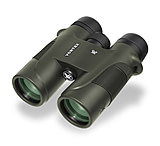A digital binocular is basically a small digital point and shoot camera placed on top of a binocular. Digital binoculars, therefore, offer the convenience of a digital camera and a binocular all in one instrument. In a digital binocular, the camera is set at the same magnification of the optic, which is usually around 8x. As a result, what you see in the camera is roughly what you'll get in a picture with the camera. Keep in mind that the picture will never be exactly the same as what you see in the binocular, since your eyes see the world differently than a camera does, but it will be close enough so that you can edit the photo as needed with photo software.![]()
Digital Binocular Numbers
The numbers in a digital binocular, such as 8x30 or 8x42, are the binocular numbers. The first number, such as the 8 in 8x30, is the magnification. This indicates how many times the image is enlarged over normal. The second binocular number is the size of the front lens in millimeters. The larger this last number, the better the performance, but also the larger the physical size of the binocular. For information on the basics on binocular construction and numbers, see our article How to Choose Binoculars.
MP - Megapixels
MP stands for mega (million) pixels. A pixel is a tiny square in a digital picture which you can easily see if you enlarge a digital picture enough or look at your computer screen with a magnifier. A 3MP picture has 2,048 pixels in each horizontal row and 1,536 pixels in each vertical row for a total of 3,145,728 pixels or simply, 3.1MP.
How important is the MP number? Not as important as most people think. There is no noticeable difference in a pic taken with 2MP, versus one taken with 3MP or even 4MP, even with an 8x10 enlargement. Other factors in a digital camera have more impact on picture quality than megapixel count, especially lens quality and processing muscle - color balance, contrast, noise reduction and so on. Since manufacturers constantly keep re-introducing the same camera with more and more MPs, you can often get as good a camera at a better price in an earlier, lower MP model.
LCD Screen for Digital Binoculars
An LCD screen on a digital binocular serves the same purpose as it does on a regular digital camera. It allows you to frame and review pics. On a digital binocular, though, a flip up LCD screen is a big plus, since you won't have to drop the binocular down to see the screen, as you must on a flat LCD screen found on inexpensive digital binoculars. Go with a flip up screen when you can.
Image Storage - SD, CF Slot
All digital binoculars have the ability to store pictures and video via internal memory, but this storage can vary significantly. When the memory is full, you must either delete the pictures download them into your computer. On inexpensive digital binoculars, this is your only option. Better digital binoculars therefore use memory cards, such as SD (secure digital) cards, to store pictures. You can then swap these cards out when one gets full, letting you keep taking pictures. This is an important feature, so check the specs if in doubt. Modern SD cards are much larger than older models, allowing you to store thousands of pictures at once.
Digital Binocular Tripod Socket
A digital binocular is like any other camera - if you want sharp pics, you have to hold it steady. This is especially true for a digital binocular, since the magnification is higher than the average digital camera. Therefore, a digital binocular which can be mounted on a camera tripod will have the potential edge over a digital binocular which cannot.
Optical Zoom and Digital Zoom
Optical zoom is enlargement or magnification of the image done with lenses and it is always preferable to digital zoom which is done with software. Remember, a digital binocular has only one optical magnification possible. Do not rely on the digital zoom function if you expect good pics. If you need more magnification, move in closer.
Digital Binocular Performance
Digital binoculars are about convenience and having fun. The picture quality doesn't usually compare with dedicated cameras, but it is more than adequate for emails or home albums. However, there some things digital binoculars cannot do.
Digital binoculars are not for shooting in low light or at night, since they have no flash and are equipped with small lenses. Digital binoculars do not have close focus capability, so they are not suited for portraits, family shots or close-ups of flowers and other objects. Digital binoculars do not have enough magnification for serious bird or wildlife photography. Lastly, digital binoculars have very limited ISO options (speed) and again, small lenses, so they are not suited for action and sports photography. Of course, digital binoculars don't cost as much as a digital point and shoot camera or a good binocular, either. That's part of the fun.






